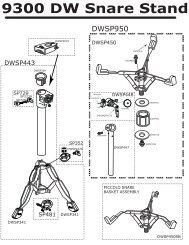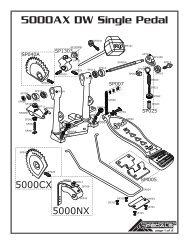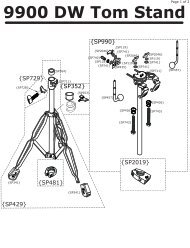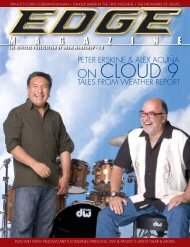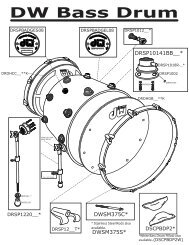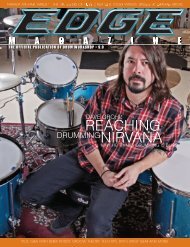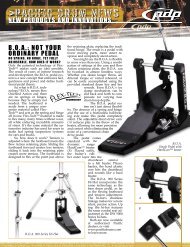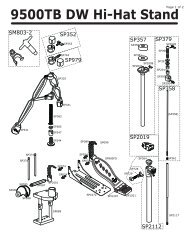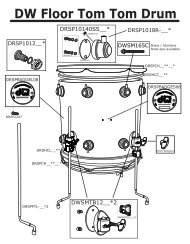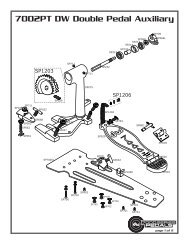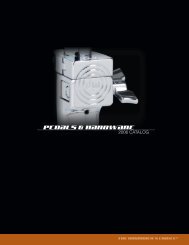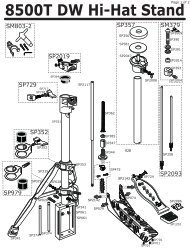QA - Drum Workshop
QA - Drum Workshop
QA - Drum Workshop
- No tags were found...
Create successful ePaper yourself
Turn your PDF publications into a flip-book with our unique Google optimized e-Paper software.
TECH TIPSB U I L D I N G T H E P E R F E C T T O U R K I TB Y S T E V E R I N K O VG E T T I N G A K I T R E A D Y F O R T H E R O A D I S N E V E R E A S Y. S O W H O G E T S T H E C A L L ? I T ’ ST H E P R O F E S S I O N A L S B E H I N D T H E P R O D R U M M E R S , T H E D R U M T E C H S . T H E S E G U Y S A R E S E A S O N E D E X P E R T S A N D H AV ES E E N A N D D O N E I T A L L I N T H E D R U M B I Z . I N E A C H I S S U E , T E C H T I P S D E L I V E R S I N S I D E S E C R E T S A N D S U G G E S T I O N SF R O M S O M E O F T H E W O R L D ’ S T O P T E C H S .major drumhead companies offer sucha broad selection of high quality headswith extremely diverse sounds thatfinding some that are durable, in additionto offering just the right sound,isn’t a problem.EDGE: What should be in every touringtech’s toolbox?use what they have for years, like MickFleetwood. Or with Jimmy Paxson, whoI happen to be working with now on theupcoming Stevie Nicks tour, he chosedrum sizes that best suit the music.EDGE: Should drummers and techs be concernedwith monitor mixes, or is that strictlyleft to the audio guys?Steve Rinkov with rock and roll iconMick FleetwoodEDGE: Is there a preferable finish? Is lacquera better bet than a wrap, or vise versa?Steve Rinkov: From my perspective, Iprefer a wrap to a lacquer for durability.When taking drums in and out of roadcases each night, drums are likely toincur the odd nick or bump. Wrappeddrums tend to hold up better than thelacquer.EDGE: How many snares is too many onthe road?SR: I don’t know if there’s a rule abouthow many snare drums one needs. Ihaven’t worked for anyone who usesmore than two on a kit, and I’ve foundthat one spare for each snare on the kit isenough to get out of any dicey situationquickly. Also, I’ve been lucky in that forthe tours on which I have worked, thedrummers haven’t made changes totheir sound once we left rehearsals, soI didn’t need to carry extra drums foroptional sounds.EDGE: Is sound or durability the primaryconcern when choosing head combinations?SR: My main objective is to help thedrummer achieve his or her sound.After that, it’s about finding a balance.I’ve worked with people who like thecalf head sound in the studio, but that’sjust too hard to control on the road, andthey’re just not dependable. All of theSR: Great question. I tour with a fairlylarge road case filled with a multitudeof things ranging from cleaning products,tools, such as a cordless drill andsoldering iron, spare drum and hardwareparts, cables and whatever willget the job done. However, oftentimesI’ll get to work at a television show, andfor one reason or another, my case won’tbe with me, so I’ll have to grab just thethings that are most crucial. Usuallythat’s a drum key, gaff tape, a small selectionof tools and my flashlight becauseI’m often working in the dark.EDGE: Is heavy-duty hardware overkill ora must?SR: It’s certainly not overkill. EveryoneI’ve worked for plays just a little harderlive than they do in rehearsals. Seeingdouble-braced, heavy-duty hardwarehold its ground is a comforting thing.For me, it takes less effort to secureheavy hardware to the drum riser andleaves me with less to worry about.EDGE: Which parts should always havespares?SR: In my workbox, I always have aselection of snare wires, tension rods,drum keys, cymbal stand wing screws,snare string and tape. I also keep a coupleof different manufacturers’ hi-hatclutches, snare strainers and bass pedalparts. It’s a good idea to have a little ofeverything handy if at all possible.EDGE: Are sizes relative to each drummer,or are they dictated by sound and venuesize?SR: I have never been in a situationwhere drum size was determined byvenue size. In some cases, drummersSR: I can only say that being wellrounded is the key. The more you knowabout everything happening relativeto the gig, the better. When it comes tomonitor mixes, I’ve found it best to actas a communication conduit betweendrummers and monitor engineers. Oftentimes,however, it can be best to juststay out of the way.EDGE: What are some tricks to ensure theidentical set-up night after night?SR: This is a tricky one because there aresome secrets I can’t give away. I will saythat, for me, it’s important to sit behindthe drums and get a sense of the spatialrelationship between all the drums andcymbals. Also, it’s important to takenote of any strange angles. The slightestrotation of a snare drum stand canreally throw players off. In some situations,detailed measurements are necessarybut most of the time, marking onthe drum riser (a.k.a. spike marks) willgenerally ensure consistent placementeach night.Steve Rinkov began his music career as adrummer in Southern California. Fromthere, he moved to Seattle, where he openeda small, but well-known drum shop in thearea called The <strong>Drum</strong> Garage. His first experiencewith teching began in 2000 when hejoined the Lenny Kravitz camp and workedfor Lenny on the “Lenny” record. Soon following,Steve toured with Fleetwood Macon their very successful “Say You Will”tour, not only working with Mick Fleetwood’selaborate set-up, but also joiningMick on drums for several songs each night.In 2004, Steve teched for both Taku Hiranoand Teddy Campbell on the road with BetteMidler, and this year he’s been in the studiowith Matt Cameron and the boys from PearlJam on their upcoming CD release.[ E D G E 6 . 0 ] 1 5
Q & A : J A Z Z D R U M M E R Sput a little dent into that, maybe applythat type of understanding to all of themusic you play. That’s what I did withHerbie Hancock. I just applied my jazzunderstanding and language right insideof the funk. I played from the insideout. I listened carefully to whateverybody was doing, like you woulda jazz player taking the solo, and evenif I was just playing time, even now, I’mstill coming from that place. I’m a conversationaldrummer.GN: Improvisation is different as it appliesto different instruments. A drummer,in a jazz setting, is an accompanist—untilhe gets the solo thrown athim. You’re not dealing with harmony,you’re dealing with rhythm. And as adrummer, you need to really pay attentionto the other instruments in jazz andsee what it’s about. It’s a whole lineagething when you get into improvising onthe drums, because every twenty years,it completely revolutionized itself. Theone guy that I think would be the leaderin the pack would be Roy Haynes. Hewas the first guy in the late ‘40s and‘50s to stop using the hi-hat on two andfour all the time. And he started looseningpatterns up and not playing oneall the time, playing groupings of fivesand sevens and nines, and all that weirdstuff that Vinnie [Colaiuta] and [Steve]Gadd picked up on. And Elvin and Roystarted all that stuff with Tony Williams.But they went back from a lineage ofunderstanding. The ‘50s be-bop style<strong>QA</strong>&jazz, and in the ‘60s, started getting alittle looser, but when you have all thatknowledge and history behind you, itall kinda comes into play. So being animproviser takes a lot of homework.You have to check out a lot of differentstyles to make your own voice. It’s onething to just be into that whole ‘60s-erasound, but not everybody’s into thatformat. If somebody calls you for anotherkind of style of jazz, you need tobe relatively acquainted with that, too.BW: Improvisation is much like a wordgame that we all might have playedwhen we were five years old. Play oneof your favorite grooves or beats andthen go away from that groove and dosomething with your toms or cymbals.Remember in your ears what you justdid as you go back to the groove foranother couple of bars. Then go awayagain and add a little something to it.Try to have each new thing reflect whathappened before. Now you are improvising.I personally enjoy it and feelmore creative when I limit things—likeno double strokes allowed. Or, I’ll limitthe number of drums so that when Ileave the groove, I have to play either thesnare or one tom. If you are truly goingfor it, playing what your ears are askingfor, then you will inevitably makea mistake. At this point, you can stopand practice the varying stick optionsfor that pattern that threw you off. Andnow you’ve just added a personal lickor pattern that your ears asked for!EDGE: How do you generally tune yourkit? Is it the traditional way where it’s alittle tighter? Talk about that a little bit.CA: One of the things that I learnedearly on through just talking to differentdrummers is that each drum has itsown character. So you have to intimatelyget to know the instrument itself,but it also dependson the acoustics ofthe room and thestyle of music. Mydrummer, in ajazz setting, is anbasic concept is, ifI’m playing straightahead,acoustic jazz, til he gets the soloaccompanist—un-I tune the bottomhead tighter than the t h r ow n a t h i m .top head. The reason You’re not dealingwith harmony,for that is just basicphysics. The soundis going to come you’re dealing withback to you quicker rhythm. You needwhen you’re tuningthe drums at a higherpitch. There’s also tion to the otherto really pay atten-less miking wheni n s t r u m e n t s i nyou’re playing thatkind of music, as opposedto somethingjazz<strong>QA</strong>“A it’s about.”and see whata little heavier.MC: I tune my bassdrum to a G. I usetwo heads on everything,and I have an 18” bass drum, andI tune it right around there somewhere.I tune the rest of the tom-toms sort ofhigh, like a jazz sound. I always enjoyedthe sound of Billy Higgin’s tom-toms, orElvin and Tony. I don’t pick exact noteson the tom-toms, but I kind of do withthe bass drum—and yes, sort of a tight,high sound. I have a funk set, and I usethe same tom-toms. I just bring themdown a little bit, and I use a 22” bassdrum that I tune really low.BK: I tune lower than most jazz drummers.And some jazz musicians, youknow, at the beginning it drove themcrazy, but I got a big compliment fromJames Moody. I did a gig with him afew weeks back, and the way I tune thedrums, he said, “Man, I love the waythese drums sound. They sing, and theyhave a lot of body.” And this is no slightagainst jazz drummers. They tune reallyhigh, and I probably tune it closerto a funk, hip-hop tuning because thoseare my roots, and that’s what I feel morecomfortable playing. And when yousay tuning, man, this takes me to DW.There’s no other drumset on the planetthat is so easy to tune. That’s whatbrought me to you guys. And they willstay in tune, and the resonance, howthey react. I don’t change the tuning betweengenres now at all, and that’s soimportant to me.GN: Tuning for a lot of my favorite jazzdrummers, like Roy Haynes, or eventhe new guys like Bill Stewart and BrianBlade—everything’s tuned up. It’s kindof bouncy and boingy and overtone-y.Maybe it comes from Philly Joe, oneof the greatest drummers ever to havelived. But I think a lot ofit may have come fromcalfskin heads. Back—Gary Novakin the day, everythingwould tighten up whenit got cold out and thatwould become thesound, you know?BW: There are no rules,other than hopefullyusing your ears. Somemight like the toms to beextremely high or low.Many jazz drummerslike to have the tomsand bass drum soundsimilar, so the bassdrum might get tunedhigher to be played asanother punctuationpoint within the flow ofthe cymbals.EDGE: I’m guessing thebass drum sound you gofor with jazz, with traditional jazz, is moreopen?CA: I use a 14x18”, or sometimes a16x18”. What I have found with theDW bass drums is that their sound is somuch deeper and so much more versatile,that with an 18” I can tune it up ortune it down and use it for everything.you know, I’ve used some 18” bassdrums on big band gigs and recordings,and you know, and the engineer’s like,“Man, I’ve never seen anything like thisbefore.”MC: I use the traditional jazz soundwhen I’m playing jazz with an openbass drum. Every once in a while, Imake a record in the studio and there’llbe a drumset there and the front head isoff or something and you sort of haveto play it. So, not all of my records accuratelyrepresent my sound, but whenI play live, that’s what I do.
ON THE RISEN AT H A N F O L L O W I L L : K I N G S O F L E O NC U R R E N T L Y E M B A R K I N G on a high-profilearena tour, sharing the stage with noneother than the legendary U2, Kings of Leonare more mainstream than they had everdreamed. From VW ad campaigns to theBillboard charts, the band’s new release AhaShake Heartbreak is striking a chord withmusic fans everywhere. <strong>Drum</strong>mer NathanFollowill talks about the band’s inherentclassic rock sound, their ability to transcendbeing labeled and what it takes to rock a setof pink drums.EDGE: What’s it like having this recordblow up on you guys? On the last one, youdid a fair amount of touring and you got agood fan base going, but this one seems tobe taking you to the next level. How doesthat feel?Nathan Followill: Wereally don’t pay thatmuch attention to itbecause we’re so busy,but it’s always betterto be surprised than tobe disappointed. Butwe’re definitely reallysurprised about thisrecord.EDGE: How’s life beenon the road with U2?NF: They’ve been nothing but professional.Everyone from the guys that loadus in, all the way up to their manager,all the way to Bono and the rest of theband—they’re all amazing! They couldeasily just give us a tiny little corner ofthe stage and stick us up there just tokill time while their fans file in, butthey’re really cool, really pro. We’re upin Seattle right now, and two nights ago,Eddie Vedder got up there and sang asong with us in his hometown, and thecrowd went insane. So, that right therejust lets you know the kind of band thatthese guys are—that they let the openingband have a special guest on that’sgonna get the place going crazy. Soyeah, they’ve been great.EDGE: What were some of your earliestmusical influences? Kings of Leon have atimeless, classic sound, even though youhave that modern edge. I’m sure you guyshear the term “classic rock” often. What inspiredyou?NF: Man, I think we were inspired by“It’s better to fail doingwhat you thinkyou should be doingthan to succeedand be miserable...because you thinkyou sold out.”the fact that there really was no inspirationin the beginning, you know? Wegrew up sheltered, in a sheltered household,our dad being a preacher and all.We couldn’t listen to rock and roll oranything like that. So, I think the thingthat helped us out the most was that itcomes from a pure place. It comes fromsomething natural. We didn’t hear aband and say, “Wow, we’re going to recreatethat and be our generation’s versionof that.” So I think it helped us out,the fact that we just did it the way wefelt it. And luckily for us, people thinkit’s classic and pure, and that’s wonderful.We’ll take that any day of the week.EDGE: You’ve played small places like thefamous Roxy Theatre here in Los Angeles,and now you’re playingmassive venues withthis U2 tour. Do youhave a preference—largeversus small?NF: Well, I don’tknow. We’re prettyeasy to please. Thefirst couple of showsin the arenas werepretty tough becauseof the sound, youknow? We’re not usedto that. Especially going from a club fullof 500 sweaty kids to a place that seats20,000. So, it kind of threw us for a loopat first, but now, you know... we’ve beendoing our own one-offs in between theshows with U2—which is another thingthat’s unheard of—the fact that they’reletting us do our own shows. Stick usin the 20,000 seat arena, or in the basement,we’re just going to plug in.EDGE: You’re in a band situation in aunique way with your family—getting intocreative arguments and dealing with thepolitics of being in a band. How does thatplay out when you’re dealing with yourbrothers and family members in that way?What’s that dynamic like?NF: Most bands that have had their siblingsare known for their arguments andtheir blowouts, but I don’t know. Whenyou look at it, we’re really the onlythings that each of us have on a consistentbasis. And you know, we haveour little fall-outs, we have arguments,but at the end of the day we’re lookingforward to seeing each other at Thanksgivingand Christmas, so nothing canbe too big to make us pissed off enoughwhere we won’t talk to each other forfive years, or break up the band or anythinglike that.EDGE: So, after picking up the drums inchurch, how did you develop the skill ofplaying drums and singing at the sametime? That’s also not easy to do.NF: Church, too. Yeah, when I wasabout nine, I’d say, there was this kidthat went to church school with me,and he could tear up a piano. And hewas, like, eleven, but we were kind ofboth in the same boat in that we pickedup an instrument at a young age andwere able to play it a lot better than weprobably should have been able to. Butthat’s really where it started. He wouldplay the piano and sing, and I wouldplay the drums and sing, and we wouldjust sit there and write horrible, horriblesongs and sing ‘em. But, looking backon it now, it’s kind of cool. It definitelyhelped me out with my profession.EDGE: So, what made you decide to go witha pink drum kit?NF: To be honest with you, I don’t thinkI’ve ever seen a pink drum kit before.EDGE: So you’re just going for somethinga little different.NF: Yeah. I mean, I look like Grizzly Adamshere. I don’t think anyone’s goingto question my motives for me playinga set of pink drums if I look like I just bitthe head off of a squirrel, you know?EDGE: What advice do you have for anyyoung drummers that are trying to getstarted in a rock band and make it big in themusic business?NF: Do what you feel. Don’t try to playthe drums like this person or that person.Don’t try to model your careerafter this person or that person. At theend of the day, you’ve got to live withyourself and your band, and you gettired of a CD eventually if you listen toit to much, so just be original. Don’t bescared to be original. It’s better to faildoing what you think you should bedoing than to succeed and be miserableand not sleep at night because you thinkyou sold out.[ E D G E 6 . 0 ] 2 1
TechLock ®SM2031“PuppyBone”Quick-ReleaseDual Ratchet AvailableAccessories:SM2034Cymbal TilterSM2035Percussion ArmSM2030CounterweightMegaTripodBase9702MultiStandSET-UP OPTIONSDUAL CYMBALSET-UPEFFECTSCYMBALSET-UPPERCUSSION/CYMBALSET-UPDUALCYMBAL/BELLSET-UPPERCUSSION/EFFECTSSET-UPDUAL CYMBALSET-UP
NASHVILLEKNOW-HOWI T ’ S N O E A S Y TA S K , F O R G I N G A L O N G - L A S T I N G C A R E E R I NM U S I C C I T Y, U S A . T H I S S O N G - S AV V Y T E N N E S S E E N AT I V EW E N T F R O M L E A R N I N G T H E R O P E S T O W O R K I N G W I T H T H EW H O ’ S W H O O F C O U N T R Y, B L U E S A N D R O C K . > > >EDGE: How long have you had your rootsplanted in Nashville?Chad Cromwell: I came here in the fallof ’90, ‘cause I’d actually just finished aJackson Browne tour, and I came hereto live.EDGE: Where were you before?CC: Memphis. I was in Memphis, but Iwas commuting basically between L.A.and San Francisco all the time, workin’out west. Because at that time, in thelate ‘80s, mid-to-late ‘80s, I was reallyinvolved with Joe Walsh, and Jackson,and Neil Young. Primarily, it would’vebeen Neil and Joe Walsh. So I was, like,ping-ponging between record projectsand tours with Joe and Neil.EDGE: How has the scene changed in Nashvilleover the years since you’ve been there?CC: Well, it’s undergoing a really wholesalechange right now. And what I’m noticingis that the boundaries, musically,seem to be shifting back toward artistsinger-songwriters. Not necessarily tojust be traditional country, but there’sevidence of even traditional countrysort of making a comeback, as well asthe sort of edgier singer-songwriter artists.For example, Miranda [Lambert]’srecord, if you listen to that, you’re goingto hear elements of Texas, like TexasBlues Shuffle stuff, you’re going to hearkind of a pop vibe and you’re going tohear traditional country. It’s a really interestingmixed bag, and my take on thatis that the young artists are just bringingtheir influences to the table. And theirinfluences can mean anything. And I’vealways thought of country music as likethe white man’s blues, you know? Andit seems like right now, that sense ofcountry is beginning to kind of make itscomeback. And then there’s the generationthat are just as likely to buy AshleeSimpson records, they might go andbuy Miranda’s record and get exposedto a whole different bag altogether. Andyou’re talking about polar opposites interms of production style and songwritingand that whole thing. Just the wholemethod is completely different.EDGE: Have you consciously positionedyourself as a country-tinged rock or bluestype of player, or is that where you have justnaturally gravitated?CC: Well, my recurring theme seems tobe that I find myself working with singersongwriterguitar players. There’s a lotof that in my life. I’ve got Neil Young—that’s a prominent role in my life. MarkKnopfler—prominent role in my life.Joe Walsh—prominent role in my life.Jackson Browne and Bonnie Raitt, let’ssee—who else? There’s also Vince Gill.These are all singer-songwriter guitarplayers. And either I have a languagethat they understand, or vice-versa. I’mnot quite sure how that works but it’snot so much about the drumming thing,it’s more about the song thing. It’s moreabout interpreting songs.EDGE: So you attribute that to chemistry?CC: Yeah. It’s definitely a chemistry anda conversation, a musical conversation,that has to happen, and is deeply rootedin rhythm and blues. Being raised inMemphis throughout the ‘60s and ‘70s,my school, in fact my teacher, was JimStewart, the guy who started Staxx Records.EDGE: But Staxx is more an R&B thing?CC: Absolutely. Full-on R&B, yeah.EDGE: So where you come from is definitelya different flavor from where you’veended up.CC: Absolutely, absolutely. But thethread that goes through it all is stillabout songwriting and songs, and interpretingsongs with a kind of feelingabout them.EDGE: So, how do you get gigs? Is it wordof mouth, or do you actively contact artistsyou’d like to work with?CC: Mainly word of mouth. All theresumes in the world will maybe getyou in a door to meet somebody, butthe way it really happens is if you doa great job for somebody who thensays, “Man, you oughtta check this catout. He’s happening,” or, “He might beright for your thing.” And then after afew years of that, you finally build upenough of a reputation to where peoplebegin to get an idea of what you cando. And maybe it can be applied to severaldifferent genres, and not just one,you know. And that’s what I have beenblessed with. One day I’ll go and play ona soundtrack to a film, and the next dayI’ll be doing some hard-core blues datewith somebody, and then the next dayit’ll be Vince Gill, or Leanne Womack,or you know...I guess I never knowfrom day to day what I’m gonna walkinto. I’ve seen it all. I mean, from a popdrummingstandpoint, I should say,I’ve seen it all. I just did this instrumentalrecord with Chuck Lavelle. Chuckis one of the original keyboard playersin The Allman Brothers Band. He alsohad a band called Sea Level back in the‘70s. He’s been with The Rolling Stonesnow for, like, twenty-five years I think.Hammond, Wurlitzer and piano, that’shis thing. He’s a brilliant musician. Andso I just did this jazz record with him.I’m not a jazz player! But what I cando is I can interpret songs. I can bringsomething that I don’t even know howto technically explain to you, but it’sjust this organic, cellular feel. And I canmorph that into many different things.EDGE: Would you say that you played“jazz”, or that you did your interpretation
63187245CHAD CROMWELLofwhat you think jazz should be?CC: I did my interpretation. Iwould never in a million yearsprofess that I can play be-bop.As much as I’d love to, man, youknow, that’s not me. I mean, I’m a fanof it, but only from a safe distance.That’s not my genre as a player.EDGE: Are you into jazz?CC: As a fan, yeah, I love it. Butthat’s such a completely differentdiscipline and technique. My thingis that all my patterns are built fromthe bass drum up, okay? And, like,in a be-bop kind of approach, as youwell know, the bass drum is actuallymore of an accent than the actualfundamental groove.EDGE: Well yeah, in jazz, the groovecomes from the ride cymbal.CC: Absolutely. It’s all ride cymbalwith accents. And that’s just not at allwhat my forté is. But, man, do I lovelistenin’ to it. I just love listenin’ to allthose guys, like, [Ed] Thigpen, Elvin[Jones], and all those guys back inthe day. Buddy Rich—all those guys.You know, there’s just too many tocount. Absolutely astounding musicians.EDGE: Well, you’re taking a break, butyou’re currently on the road with MarkKnopfler. Getting back to songs, howmuch emphasis do you place on replicatingdrum parts? I’m imagining you haveto cop a ton of Dire Straits classics.S E T- U P S P E C S :Collector’s Series® Maple <strong>Drum</strong>s withNatural Lacquer over Mapa Burl Exoticand Chrome Hardware14x22” Bass <strong>Drum</strong>5x14” Aluminum Snare <strong>Drum</strong>8x10”, 9x12”, 14x14”, 16x16”Tom-Toms9000 Single Pedal9500 Hi-Hat Stand9934 Double Tom/Cymbal Stand (x2)9700 Straight/BoomCymbal Stand (x3)9300 Standard SnareStand9100M Standard<strong>Drum</strong> ThroneCC: I try to honor the parts thatthose guys wrote for those records,because there’s a feeling at the timethose songs were recorded. And so,for example, when I play “Sultans ofSwing” with Mark, that’s a very kindof jazzy-feeling track from the drumkit.And it’s very on top of the beat,and very sort of light in style, lots offills and a lot of movement in the kit.And that’s not my thing, really, butI took it upon myself to try to honorthat feel because it plays a large rolein the way the song sounds. And if Iwere to change the tack of the grooveon that song, it would change theway Mark is able to sing it.EDGE: Talk a little about playing withNeil Young.CC: Well, playing with Neil to meis the ultimate soul music for whitemen. And the reason I say that is Idid two records with him. I did theFreedom album, with a song called“Rockin’ In The Free World” on it,and then I did this record called Neil[ E D G E 6 . 0 ] 2 5
It’s not so much about the drumming thing, it’s more aboutthe song thing. It’s more about interpreting songs. ...It’s like,“Alright, this is not about crafting a record here, man. This isabout taking a picture of a song being born.”Young and The Bluenotes prior to that record.EDGE: That was his blues record, right?CC: Yeah, kind of a blues, big-band kindof a thing, with his obvious signature onit all. But yeah, just a blues record essentially.But, the thing is with him, heis the most “in-the-moment” cat I haveever worked with in my life. And we’rejust in the middle of a project right nowtogether—and I had forgotten, becauseit’s been almost fifteen years since we’vebeen in the studio together—but it suddenlycame rushing back to me and it’slike, “Alright, this is not about craftinga record here, man. This is about takinga picture of a song being born.” I mean,right out of the gate, you know? And tojust get as much of the gold dust as it’scoming out as possible, and being happyand willing to live with the mistakesthat come along with it. That is deepsoul shoutin’ for a musician, man. Youknow, just hangin’ it out there.EDGE: When you’re being a chameleon andyou’re changing the style of play, how doesyour gear and your set-up transition? Forexample, how do you change your set-uplive versus studio? And how do you do itaccording to each artist’s needs and whatyou need for that particular gig?CC: Well, to give you an analogy, if Iwere going to go and do a be-bop session,assuming that I could do that, thenI probably wouldn’t send a 22” kickdrum and a 10”, and a 12”, and a 14”and 16” floor tom. I’d be more likely tosend a 14x20”, 8x12” and 14x14”. Youknow, a little trap set that speaks to thatstyle of playing and that type of music.And so, on a broader scale, every timeI start a project with somebody, I tryto get as much insight into what we’regonna go for as I possibly can, ‘cause I’llcast a drumset specifically for that artist.And I do that all the time. I mean, Ido that on country records; I’ll even castdifferent drumsets for different countryartists based on their vibe. One artistmay be a really, really hard rockin’ vibe,where another artist may be incrediblyinside and wanting something that hasalmost more to do with sound effectsthan with just a backbeat drumset. So,you know, everybody’s got their specialneeds. And Mark’s thing, for example,we built a kit with an older, traditionalkick drum vibe. I went to a 14x22”kick drum for the backline set becausethe last record that we did, really sortof was recorded in the tradition of ‘70sstyle recording, you know? Like TheBand, and from that era, and we evencut the record at the Shangri La studioright there on Pacific Coast Highway atZuma Beach.EDGE: So it’s a lot of mic bleeding and lotof live recording?CC: A lot of bleed over, a lot open, a lotof natural compression…EDGE: So you’re not tracking, really, you’rejust playing?CC: We’re playing for performances. Sowith that in mind, if I send out an 18x22”rock’n’roll kit, there’s no way sonicallyyou’re going to be able to reproducewhat I did on the Shangri La record. So,I built the kit up so that I could covereverything from ‘70s style recording, including“Sultans of Swing,” or the newShangri La record. Or if I needed it, Ihad the time configurations and cymbalconfigurations that would allow me tobe playin’ “Money for Nothin’” on onesong, full-on blasting rock’n’roll on anothersong, and even jazz.EDGE: So from jazz to heavier stuff, whatdo you look for in a snare drum?CC: The snare drum. That’s the drumwith the most personality, so that gets alittle tricky for me [laughs] because thisgoes back to early ‘20s Ludwig Standardsor Black Beauties. And they sortof became my language on snare drum.And then I got involved with DW, wellit’s ten years ago now, and all of a suddenall these new opportunities for mesort of came along. And so, I’ve falleninto a thing where one day it’ll be anEdge snare drum, the next day it’ll be asolid shell 7x13”, you know? Just differentkinds of approaches to snare drumthan traditional, old-world methods.But what I’m leading up to is the VLTkit….EDGE: [laughs] You’re answering my questionsbefore I get to ‘em, but keep goin’…CC: Well, I’m gettin’ ready to. I’m gonnago with ya because, I’m tellin’ ya,I’m your poster child for VLT drums.They’re my sound. And that’s been aquest for me. You know, I’ve had somegreat kits from DW, and I mean youguys have been great with sortin’ meout. But man, when I got a hold of theVLTs it was just like, “This is me. I wantto make noise about VLT.” And thesnare drums, I don’t know what’s upwith that, but they’re unbelievable. AndI’ve been using two kits on Mark’s tour,
one of which is the big backline set, andthen I use a smaller, jazzy kind of set fora whole different part of the show. Andthe VLT is on that small kit for the wholeset. And then recording, I’m using VLTsall the time. It’s the first time I played asnare drum that gave me back what myold ‘20s Ludwigs do.EDGE: Interesting, because the Ludwigsnares, the Black Beauties, obviously were abrass shell.CC: That’s right.EDGE: And VLT is a ...CC: ...maple shell. But there’s somethingin the feel of it. It’s the way when thestick lands on it, and the grace notes, andall the stuff that I do with a snare drum,you know? Because I’m a backbeat styleplayer, sound is everything. I need options,you know? And it inspires me toplay in different ways. And when I got ahold of the VLT drums, it got me into aplace that made me want to go down adifferent path. It wasn’t like, “Oh that’sdifferent. Well, that’s kind of interesting.Well, I don’t know if I can use that veryoften, but, you know, I’ll reach for it occasionally.”And consequently, I’ve gotlike 40 snare drums.EDGE: We talked about some of the Staxxstuff early on that influenced you, but thebackside of that question is, what influencesyou today? Do you listen to a lot of music?CC: I do. Not quite as much right now asI’d like to, mainly because I’m a father,you know? And if I’m not workin’, thenI’m bein’ a dad. So, listening to music basicallycenters around what they’re intolistening to now, you know? So, whenI’ve got the radio on, I’m hearing a lot ofhip hop, and I’m hearing a lot of AshleeSimpson. I’ve got young ones, nine andtwelve years old, and so they’re into stuffthat I might not necessarily reach for.But if I’m listening for my own pleasure,I seem to be listening to a lot of MilesDavis and Oscar Peterson right now…which is notmy genre,but it’s like,“Man, thisfeels goodto listen tothis.” It getsme in a goodplace. AndI’m kinda waiting on my rock’n’rollbuzz. There’s just not really much goingon right now that’s killin’ me.EDGE: What do you see yourself doingnext? Do you look beyond the projects thatyou’re working on at the moment?CC: You know what, this has been avery, very interesting time for me in howall this is coming together. I’ve gonethrough a real spiritual awakeningright now as a musician, aswell as a human being. And thatwould probably end up being awhole ‘nother topic to discuss anothertime, but musically-speaking,man, I don’t know where I’mheaded. And that’s kind of beenthe constant theme throughoutmy whole career. It’s like, if youwould’ve told me in 1985 that Iwas going to live five years laterin Nashville, Tennessee, and startplaying country music, I’d’ve toldyou you were out of your mind.And I totally dig livin’ here now.There’s some really cool stuffhappenin’ in this town. I neverexpected to be back in the studiowith Neil again, and here I am.Right in the middle of a project inmy home town.EDGE: Is this a whole new record you guysare working on?CC: It’s a whole brand new thing. Hejust came [and] it was a very heavy experienceover this past week. We gotinto these sessions and I’m really kindaon the edge right now of really needingto chill for a while. I’ve been pushin’ toohard. I get off of this tour that I’m friedfrom, and I’ve got Neil waiting on me tostart recording. Well, I jump in the studiowith Neil, and we’re recording thesesongs like mad, you know? Let me tellyou— we cut the track, thirty minuteslater EmmyLou Harris is comin’ throughthe door to sing background vocals andan hour after that, string players are arrivingto do the strings. It’s, like, insane.And so, you know,where do I see myselfin the future? I haveabsolutely no idea. Ijust know I’m gonnato go into it with botheyes wide open andI’m gonna play myheart out. And if I can’tplay my heartout—forgetit! O N T H ER E C O R D :H A R R Y M C C A R T H Y:Life on the road is tougher than everthese days. I recently told Chad thatsome days I feel like an old athletethat doesn’t know when to hang itup. I am veryfortunate as Ican pick andchoosethegigs I do. Andwith owning<strong>Drum</strong> Paradisein ville, I don’tNash-need the roadbut it’s in myblood and Ido it for thefinancial rewards.Chad andI will usuallydiscuss whathe’s goingafter beforeI send hisequipment tothe studio, sohis set up will depend on the project.He likes to play a 5-piece DWkit in the studio: 22”, 10”, 12” and16” with a 5x14” snare.As far as his road set-up, he willadd a 14” floor tom and maybe afew extra crash cymbals.Chad has always been openminded about trying different drumhead combinations. I will suggestsending certain drums to a sessionbut Chad knows what he wants touse when he’s recording. On somerecord dates he may be there for afew days or longer so I may sendmore than one DW kit with someadditional snare drums and cymbalsĊhad is a very spiritual andsoulful player with no ego. Hisgroove is serious and his approachto drumming is all about the song.He can play it all on the drums butyou will never hear him over playingin the studio or live. He continuesto have an amazing run here inNashville and outside of Nashvilleand that is quite impressive thesedays.Harry McCarthy, drum tech and ownerof <strong>Drum</strong> Paradise Nashville, Inc., hasbeen working with many of the world’sleading drummers in the studio and onthe road for over 20 years.His most recent tours includeBruce Springsteen and the E StreetBand’s last two world tours.[ E D G E 6 . 0 ] 2 7



